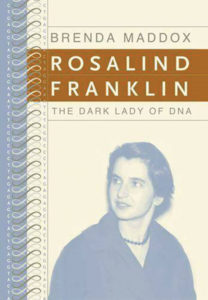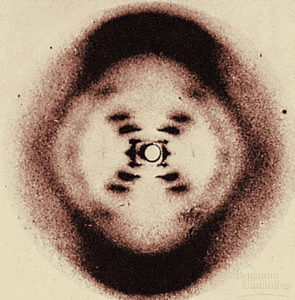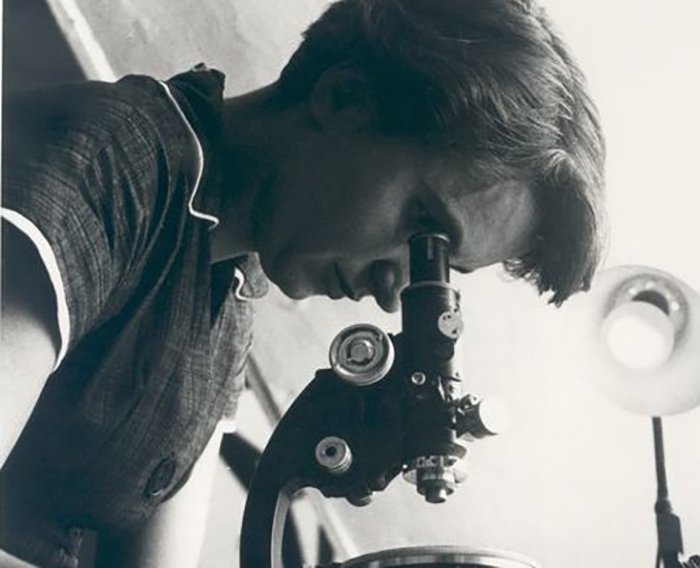Credit: Jenifer Glyn/Wikimedia Commons, CC BY-SA
This month marks the centenary of the birth of Rosalind Elsie Franklin, who was born in Notting Hill, London, on July 25, 1920. Her experimental studies on the structure of DNA gave rise to the double helix in the early weeks of 1953, even though her contributions were barely acknowledged at the time and her character tarnished 15 years later in Jim Watson’s chauvinistic bestseller, The Double Helix.
 Thankfully, Franklin’s pivotal role in the double helix drama has been restored, helped along the way by Life Story, a superb 1987 BBC film (starring a young Jeff Goldblum and a brilliant Juliet Stevenson), and a nuanced biography by the late Brenda Maddox, Rosalind Franklin: The Dark Lady of DNA, who countered the perception that Franklin was the doomed “Sylvia Plath of molecular biology.” In 2015, the Australian star Nicole Kidman, the daughter of a biochemist, portrayed Franklin to critical acclaim on London’s West End in Photograph 51.
Thankfully, Franklin’s pivotal role in the double helix drama has been restored, helped along the way by Life Story, a superb 1987 BBC film (starring a young Jeff Goldblum and a brilliant Juliet Stevenson), and a nuanced biography by the late Brenda Maddox, Rosalind Franklin: The Dark Lady of DNA, who countered the perception that Franklin was the doomed “Sylvia Plath of molecular biology.” In 2015, the Australian star Nicole Kidman, the daughter of a biochemist, portrayed Franklin to critical acclaim on London’s West End in Photograph 51.
The title of that play comes from Franklin’s most famous experiment. In May 1952, working with her student Raymond Gosling in a cellar laboratory at King’s College London (KCL), she captured a magnificent X-ray photograph of stretched DNA fibers in the B, or wet form. (The DNA was supplied by Swiss biochemist Rudolf Signer.) The image was an unmistakable “X” configuration, but Franklin, more interested in the more detailed pictures derived from the A form of DNA, filed it away. In so doing, she also cast aside the notion that DNA was a helix.
Franklin was deeply unhappy at KCL, not so much because she was a woman in a man’s world but because, as Maddox observed, “a wealthy Anglo-Jew felt out of place in a Church of England setting dominated by swirling cassocks and students studying for the priesthood.” She showed particular disdain for her KCL colleague Maurice Wilkins, a potential ally and collaborator. Toward the end of 1952, she was ready for a fresh start in the “nonsectarian” setting of Birkbeck College.
Meanwhile, in Cambridge, Francis Crick and Jim Watson had been prohibited from building models of DNA after a disastrous first attempt in 1951 involving triple chains was embarrassingly torn apart (not literally) by Franklin during a quick daytrip to the Cavendish Laboratory. But a year later, with the great Linus Pauling entering the race, the duo persuaded their boss, Sir Lawrence Bragg, to let them have another crack.

Two priceless pieces of information, both sourced from Franklin without her knowledge, were critical to the assembly. First, Wilkins showed Watson a copy of Franklin’s Photo 51 in late January 1953. (With Franklin preparing to leave KCL, Gosling had recently handed Wilkins the photo almost as a souvenir.) “My mouth fell open and my pulse began to race,” Watson recalled. Although not a trained crystallographer, he had learned enough to know that “X” marked a helix—probably a double. “Even though [Crick] was a physicist,” Watson memorably wrote, “he knew that important biological objects come in pairs.”
A short time later, Crick and Watson’s colleague Max Perutz shared a copy of a Medical Research Council report on the KCL biophysics department that he had received in mid-December 1952. It included Franklin’s precise measurements of the B form, including key evidence that the helices ran in opposite directions. Nothing was stolen—the MRC report was not marked confidential—but nor did anyone at the Cavendish inform or consult Franklin about the model building that was now ramping up in earnest using her data. (After publication of The Double Helix, Watson apologized for any impression in the book that Perutz had acted inappropriately.)
Crick and Watson’s DNA jigsaw was completed with assists from several other sources, including Erwin Chargaff’s curious observation of a 1:1 ratio of certain bases and Jerry Donohue’s insight on the correct chemical isoforms that proved the clincher. And then there’s William Astbury, who had provided evidence for the stacking arrangement of bases, but did not grasp the significance of his own student’s B-form X-ray image with the trademark “X” pattern captured a full year before Franklin.
Watson found the two matching base pairs—A binds to T, C to G, big meets small—on a Saturday morning, February 1953, before enjoying a pub lunch with Crick at The Eagle. Invited back up to Cambridge to view the new two-chain model, Franklin understood immediately that it must be more-or-less correct, even if she didn’t realize just how much Crick and Watson had relied on her data.
Crick and Watson offered token thanks to Franklin in a footnote to their Nature paper that conceded a “general knowledge” of her unpublished results. Things might have been different if the papers had crossed the desk of the late Sir John Maddox, Brenda’s husband and editor emeritus of Nature, who first took the reins of the journal in 1966. Far from “a general knowledge,” Maddox said, “in fact, they had particular knowledge of her work, and I, as an editor, would have smelled a rat at that.” Indeed, he might have insisted that Franklin be credited as a co-author.
Arrangements were made for Franklin and Wilkins to publish their data separately in the same issue of Nature alongside the double helix. Franklin and Gosling’s paper included the now-iconic Photo 51 but ironically no mention of DNA—instead it was sodium thymonucleate. Franklin stated cautiously that the genetic material was “probably helical,” with the phosphate chain on the outside. Appearing as the third article, Franklin’s paper gave the mistaken impression of being a confirmatory study instead of supplying the crucial primary data. Shortly before publication, she inserted a sentence: “Thus our general ideas are not inconsistent with the model proposed by Watson and Crick in the preceding communication.” Well of course they weren’t—the double helix model sprung from her data!
If Franklin felt robbed or was upset by losing the race, she never let on. She became friends with Crick and Watson, staying with the Cricks in Cambridge before her death in 1958 of ovarian cancer (likely triggered by her prolonged exposure to X-rays). As Brenda Maddox said: “She was cheated of the only thing she really wanted, which was the chance to finish her work… Her lost prize was life.”
As former colleagues have insisted, Franklin would surely have deduced the structure of DNA herself. Crick and Watson both felt Franklin’s biggest disadvantage was that she didn’t have anyone at KCL to talk to. Her death robbed her of a share of the Nobel Prize in 1962; instead, it was Wilkins who was honored alongside Crick and Watson.

[Science History Images / Alamy Stock Photo]
In the last few years of her life, Franklin did superb work on the structure of tobacco mosaic virus. Franklin was laid to rest at a synagogue a few miles north of her birthplace. Her epitaph reads: “SCIENTIST: Her research and discoveries on viruses remain of lasting benefit to mankind.” Her name lives on with a university, a research institute, and many halls, prizes, and societies named in her honor, as well as a Mars rover. The legacy of the “dark lady”—for women in science and the unbridled love of doing science—will shine brightly for centuries to come.



